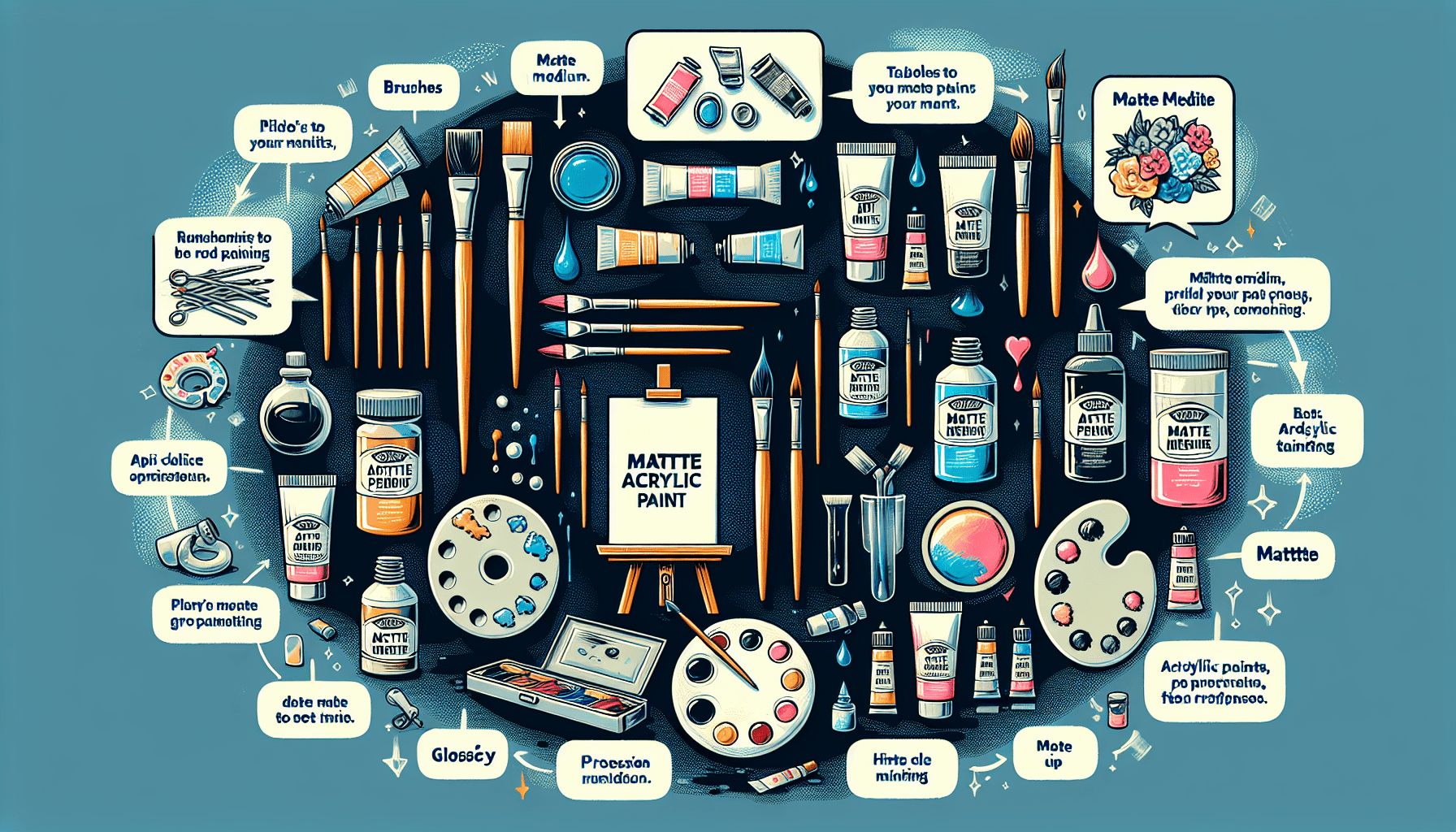Painting metal can open up a world of possibilities when it comes to reviving old furniture or adding a pop of color to your outdoor decor. But when it comes to choosing the right type of paint, many people wonder if acrylic paint is suitable for the job. The answer is a resounding yes! Acrylic paint provides excellent adhesion to metal surfaces and offers a wide range of vibrant colors to choose from. So whether you’re looking to transform a rusty old toolbox or give your metal garden sculptures a fresh new look, acrylic paint is a reliable and versatile option that will have you painting metal like a pro in no time.
Choosing the Right Acrylic Paint
When it comes to painting metal with acrylic paint, choosing the right quality of paint is essential for a successful and long-lasting result. Acrylic paints come in a wide range of qualities, ranging from student-grade to professional-grade.
Student-grade acrylic paints are more affordable and are suitable for beginners or for projects that don’t require a high level of durability. On the other hand, professional-grade acrylic paints offer better pigmentation, color vibrancy, and resistance to fading, making them perfect for more intricate and demanding metal painting projects.
When selecting acrylic paints for metal, pay attention to the label and look for paints that specifically mention their suitability for metal surfaces. These paints often contain additives that enhance adhesion and durability, ensuring that your painted metal surface stays intact for a longer time.
Choosing the Right Color
Once you have chosen the quality of acrylic paint, the next step is to select the right color(s) for your metal project. The color choice will depend on your personal preference, the purpose of the painted metal, and the overall aesthetic or design you want to achieve.
If you’re unsure about which color to choose, consider the environment where the painted metal will be placed. Earth tones such as browns, greens, and blues work well in natural settings, while bright and bold colors can add a pop of vibrancy to urban or modern spaces. Additionally, metallic shades can create a unique and eye-catching effect on a metal surface.
Keep in mind that acrylic paints can be mixed together to create custom shades, so don’t be afraid to experiment and get creative with your color choices. It’s always a good idea to test the color on a small, inconspicuous area of the metal surface before painting the entire piece.

Primer for Metal Surfaces
Before diving into the painting process, it is crucial to prepare the metal surface properly. One of the essential steps in this preparation is applying a primer.
A primer serves as a base coat that helps the acrylic paint adhere better to the metal surface. It also provides an extra layer of protection, preventing rust or corrosion from forming on the metal over time.
When choosing a primer for metal surfaces, opt for one specifically designed for use with acrylic paints. These primers are formulated to bond effectively with acrylic paint, ensuring a smooth and lasting finish. Look for a primer that is rust-resistant and quick-drying, as it will save you time and effort during the painting process.
Preparing the Metal Surface
To ensure a successful metal painting project, it is essential to prepare the metal surface properly before applying any paint. This involves cleaning the metal, sanding the surface, and applying a primer.
Cleaning the Metal
The first step in preparing the metal surface is to thoroughly clean it. Remove any dust, dirt, or grease that may be present on the metal. You can use a mild detergent or a degreaser to clean the surface effectively. Rinse the metal with water and allow it to dry completely before moving on to the next step.
Sanding the Surface
Sanding the metal surface helps create a rough texture that allows the primer and paint to adhere better. Use sandpaper or a sanding block with medium-grit or fine-grit to gently roughen the surface. Be cautious not to sand too aggressively, as it may damage the metal.
After sanding, use a damp cloth to remove the dust or particles created during the sanding process. Ensure that the metal is completely clean and free from debris before proceeding.
Applying a Primer
Once the metal surface is clean and sanded, it’s time to apply the primer. Using a brush or a roller, evenly coat the metal surface with the primer. Follow the instructions provided on the primer’s packaging for the best results.
Allow the primer to dry completely before proceeding to the painting step. Refer to the product’s drying time to ensure that it has set properly before applying the acrylic paint.

Painting Techniques for Metal
Now that the metal surface is properly prepared, it’s time to explore different painting techniques for metal using acrylic paint. Here are three popular methods: brushing, spray painting, and using a roller.
Brushing Method
Using a brush is a common and versatile painting technique for metal surfaces. Dip your brush into the acrylic paint and apply it to the metal surface in smooth and even strokes.
When using the brushing method, consider using a brush with synthetic bristles, as they tend to work better with acrylic paint. Start by applying thin coats of paint, allowing each layer to dry before applying the next. This prevents the paint from pooling or running on the metal surface.
Spray Painting
Spray painting is another popular technique for painting metal surfaces. It provides a smooth and even finish, making it ideal for large or intricate metal pieces. Spray paint comes in a wide range of colors and finishes, allowing for endless possibilities.
To spray paint metal, ensure you are working in a well-ventilated area, preferably outdoors. Apply the spray paint in even and overlapping strokes, holding the can approximately 8-12 inches away from the metal surface. Start with a light coat and gradually build up the intensity by applying multiple thin layers until you achieve the desired coverage. Allow each layer to dry before applying the next.
Using a Roller
Using a roller can be an efficient technique for painting large, flat metal surfaces. This method allows for quick coverage and a smooth finish. Use a roller specifically designed for use with acrylic paint.
Pour the acrylic paint onto a tray or disposable plate and roll the roller into the paint, ensuring even distribution on the roller’s surface. Apply the paint to the metal surface in a consistent and overlapping motion, going back and forth to achieve uniform coverage. Similar to the brushing method, apply thin coats and allow each layer to dry before adding more.
Tips for Painting Metal with Acrylic Paint
While painting metal with acrylic paint can be a rewarding experience, it’s important to keep a few tips in mind to ensure the best results. Here are some helpful tips:
Working in a Well-Ventilated Area
Acrylic paints can release fumes that may be harmful if inhaled in large quantities. To protect yourself, always work in a well-ventilated area, such as an open garage or an outdoor space. If necessary, use a respirator mask to further protect your respiratory system.
Drying and Curing Time
Acrylic paint typically dries relatively quickly, but curing time refers to the time it takes for the paint to fully harden and become durable. Follow the manufacturer’s instructions on the paint’s label for both drying and curing times. Allow sufficient time between coats and avoid handling or exposing the painted metal to harsh environments until it has fully cured.
Using Thin Coats
When applying acrylic paint to metal, it’s best to use thin coats rather than thick layers. Thin coats dry faster and are less likely to crack or peel over time. Additionally, thin coats allow for better control of the paint application and reduce the risk of creating unwanted brush or roller marks.

Sealing and Protecting the Painted Metal
To ensure the longevity and durability of your painted metal surface, consider sealing and protecting the acrylic paint with a clear topcoat or a protective wax.
Applying a Clear Topcoat
A clear topcoat serves as an additional layer of protection for the painted metal. It adds a glossy or matte finish and helps prevent the paint from chipping, fading, or being damaged by UV rays. Choose a topcoat specifically designed for use with acrylic paint and metal surfaces. Follow the instructions on the product for the application process and drying time.
Using Protective Waxes
Protective waxes can also be applied to painted metal surfaces to enhance their durability and protect them from external elements. These waxes create a barrier that shields the paint from moisture, scratches, and other potential damage. Apply the protective wax following the instructions provided on the product’s packaging, typically using a soft cloth or sponge.
In conclusion, with the right choice of acrylic paint, proper surface preparation, and the right painting techniques, you can successfully paint metal surfaces with acrylic paint. Whether you’re giving a fresh look to an old metal piece or creating a unique artwork, acrylic paint offers versatility, durability, and endless color options. So, unleash your creativity, have fun, and enjoy the process of transforming metal surfaces with acrylic paint.



